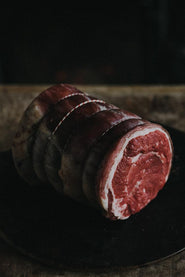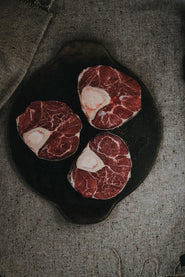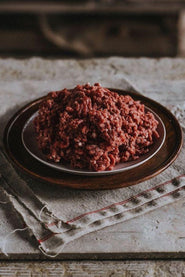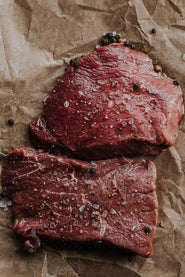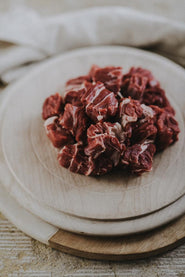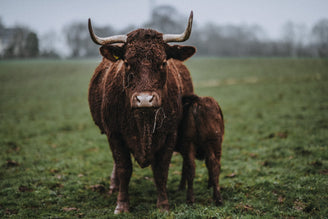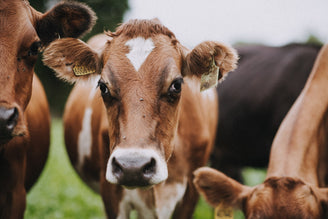The thing about news is that the simplest messages are the most powerful. They get people’s attention and start conversations, and sometimes controversies. While this is less significant with flippant celeb stories the plethora of headlines linking cows with climate change are both memorable and damning and have unquestioningly made many people think twice about dairy and beef.
Yet the reality is that the core message here, that all cows are bad, is flawed. Nuance is often collateral damage when there is a big issue that needs global attention.
As that detail sits in how, what and where cows are reared in this instance, we would like a moment to stand up for this specific nuance, and how the native breed, grass-fed cow reared on British soil is a thousand miles (literally and metaphorically) from the notional Brazilian feedlot animal upon which much of the argument here is based.
But first off let’s look at the facts of climate change, as the concerns around methane are not without foundation. It is a greenhouse gas formed of carbon and hydrogen that is significantly more potent than carbon dioxide, so it can contribute to the warming our planet at a far higher rate. Over a 100-year timescale one tonne of methane would generate 28 times the amount of warming as one tonne of CO2.
This means that, despite contributing only 3% of greenhouse gas emissions in terms of mass (tonnes of carbon), methane has been responsible for around 23% of what scientists call ‘radiative forcing’ –the thermodynamic activity behind global warming.
So-called greenhouse gases are a problem because they trap the sun’s heat within the earth’s atmosphere, much like a greenhouse lets the sun’s heat in but doesn’t let it out. The climate change this is driving creates catastrophic global issues such as melting polar ice caps, rising sea levels, major weather events like hurricanes and biodiversity loss. This is all because the biological systems, oceanic currents and weather patterns that have kept earth relative stable for millennia have been disrupted in a very short space of time. There’s no chance for nature to step in and adapt at that rate of change.
This planetary warming has primarily been caused by the release of carbon dioxide from the burning of fossil fuels in the past 300 years or so, and exacerbated by deforestation, as forests act as a carbon sink, so there is more going into the that atmosphere and less being taken out. Along with a change in land use, where green fields (vital for sequestering carbon) have been swallowed up by concrete developments. Yet methane also plays a major role, at a level disproportionate to the fact that it makes up only 17.3% of the earth’s atmosphere compared to carbon dioxide’s 74.4%.
But there’s a flip side to methane being a more potent greenhouse gas. It behaves in a slightly different way to carbon dioxide in the atmosphere, which results in it breaking down faster - just 12 years compared to centuries or even thousands of years for carbon dioxide. This means its greenhouse effects are much shorter-lived, so reducing methane levels now would reduce the concentration of methane in the atmosphere faster than reducing carbon dioxide levels will (though of course we need to do both). This is part of the reason why the pressure is on for reducing methane emissions from agriculture. It could have a bigger impact on climate change as a whole, sooner.

Now to the cows. Methane is released in the form of natural excretions (to put it bluntly burps and farts) by cows as a by-product of enteric fermentation – that is, the action of gut flora which they use as part of their digestive system. Ruminants typically release 250-500 litres of methane per day, so that certainly adds up when you consider that globally there are one billion head of cattle on the planet. According to the UN Environment Programme, livestock emissions from manure and these ‘gastroenteric releases’ account for roughly 32% of human-caused methane emissions. Indeed, methane plumes have been recorded from space being emitted by specific intensively reared animals on beef feedlots, like this one in the USA.
For the uninitiated, beef feedlots are intensive beef farms where the cows are kept in grassless pens. They are farmed by the thousand this way, typically with soya-based concentrate feed trucked to them to make them grow as fast as possible. In many cases, especially in South America, the expansion of these beef feed lots is made possible through deforestation, to create space for more such farms. Such ‘land use change’ has been cited as a significant factor in climate change, as not only is more methane released by more cows, but the concentrate feed and agrochemicals used to grow those monocultures release vast quantities of carbon through ploughing, spraying and manufacturing. Meanwhile the added deforestation, soil degradation and biodiversity loss takes away the carbon sinks. More greenhouse gases with fewer ways to remove them.
For those of you that say there are few of this style of farming system in the UK, that it’s the land guzzling juggernauts like the US where the problem lies, firstly, there are currently 789 CAFOs (Concentrated Animal Feeding Operations) on our own shores. This figure has been sharply growing in recent years with an increased rate of planning approval. However, it is important to also raise the issue that much of the food we eat today is purchased from Supermarkets who's supply chain relies on imported goods. With new trade deals, this reliance on imported food is only set to rise. Many of the foods that we currently import and will become more reliant upon, come directly from intensive farming systems that have less scrutiny than our own UK production.

Beef isn’t the only problem, there is a similar issue with some of the plant-based milks too. Many of you may have felt that doing your bit for climate change is swapping your usual diary milk coffee to a plant based alternative to ‘lower your footprint’. Unfortunately many of these products are produced using monocultures that have the same devastating negative environmental effects as feedlot cattle. They rely on great swathes suffering of land soil degradation, sprayed with huge amounts of toxic pesticides that are poising both human life and our ecosystem.
Do consider, if you are making a switch, that you really are in fact changing to a better farming system, not being lured in by greedy corporations who want to sell you more of the same environmentally damaging food just dressed up in a different costume.
Dairy and Beef cattle produce methane, there’s no denying that fact. Yet how that cow is reared dictates what the full picture of the impact is, and going back to the nuance of the issue here, it is all about the how, not just about the cow. This report by the IPCC states that there are ‘large regional differences in the contributions [of greenhouse gases] from different components of the food system’ and recognises the importance of diverse farming systems including sustainably managed pasture and livestock as a key means of mitigating climate change.

We work with small scale farmers rearing their native breed cattle on permanent British pasture, on land that has been farmed for centuries if not millennia. With small herds that graze diverse land rich in wildflowers and humming with wildlife, fertilising the soil and moving on, biodiversity is boosted and soils are enriched, not degraded.
The cattle are a vital tool in mitigating climate change in this system, they are certainly not the problem. By slowly grazing diverse pastures their excretion is placed around the land, nourishing the soils by giving it healthy natural nutrients to feed on. The movement of the cattle is also key, as they graze they will carefully tread vegetation into the soil, again providing important nutrients, vitamins and minerals to keep the army of billions of bugs and bacteria thriving. The dung is fed on by beetles and worms, who attract small birds in to feed on the insects, whilst doing so they brush against plantlife helping to pollinate a diverse range species which then further attracts more insects. Nature is in abundance and thriving here.

Keeping cattle in this natural system shapes land use in an important way, ensuring that there are acres and acres of grassland sequestering carbon (which some argue, grass sequesters more carbon than trees). Coupled with deep hedgerows that act as a secure corridor for small mammals and birds to travel, nest and eat. It's plain to see the good that this system can do.
We like to view the cattle as a by-product of good land management, providing us with highly nutrient dense food, while improving a carefully balanced ecosystem.
What’s more is that the economics stack up to – you cannot have environmental sustainability without economic sustainability. Working with family farms means the money we pay them goes back into the community, so the rural economy grows and farmers are able to reinvest in schemed such as tree planting and water management, which provides benefits to us all. Good food, healthy land, healthy ecosystems, thriving local economies. A million miles away from those corporate deforestation-fuelling companies.
As with most things, cows and climate change is not the simple equation that headlines suggest it to be. When choosing your meat and dairy, look for produce that has been properly grass fed (sometimes also referred to as pasture fed). If that means we need to consume less meat and dairy to make our budgets stretch to avoid buy one get one free chickens, then we encourage you to think more about what you value as how much you need to consume.
There’s a bigger picture behind the big headlines and it’s crucial we all get to grips with it.


